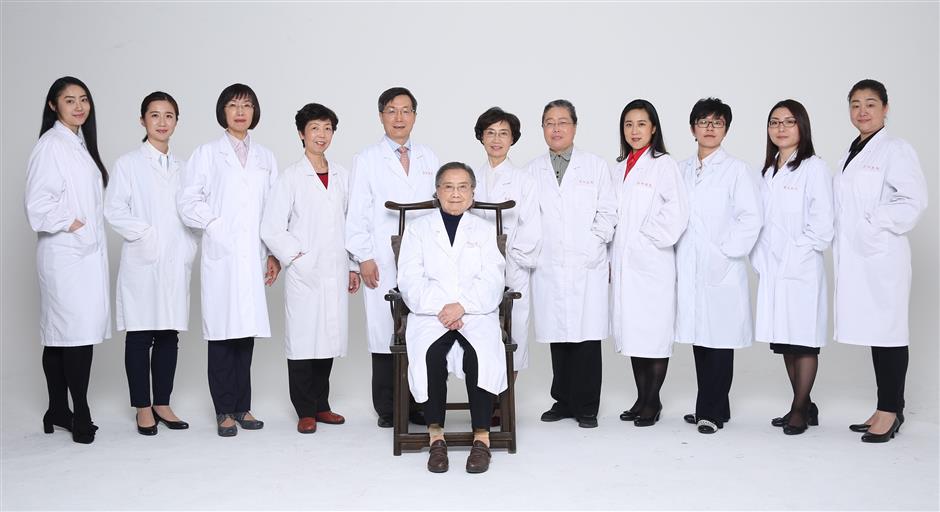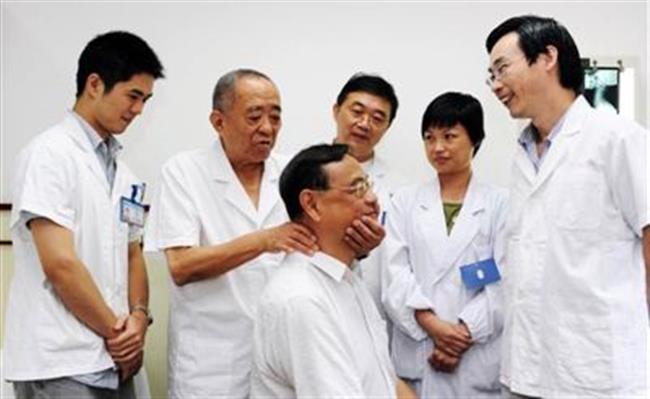Shanghai masters who have helped TCM evolve for generations
Haipai, or Shanghai style, is often used to describe theater, paintings, novels and architecture that have a strong Shanghai angle. Like the city, Shanghai style is considered inclusive and diverse. It is also true with those who practice Shanghai-style traditional Chinese medicine, which is known for its variety and constant development.
Besides Liu Jiaxiang, five other Shanghai TCM doctors have been awarded the national “TCM Master” since its inception in 2008, each with different specializations, distinct theories and clinical practices. The title is given to 30 TCM masters every five years, accounting for 90 in total till now.
Zhu Nansun, who is now 96, is the third generation practitioner of Zhu Gynecology. Zhu, who still holds half-day outpatient service every week, picked up a lot from her grandfather Zhu Nanshan.

Zhu Nansun (sitting) and her students
She is especially known for treating infertility. Many women, who got pregnant after long years of suffering, call Zhu “Songzi Guanying,” or the “Goddess of Mercy who sends children to families.”
Her grandfather was a famous doctor in Jiangsu Province. He moved to Shanghai in 1916 and came to be known as “one dose” Zhu for his precise diagnosis and prescription. Most patients would feel better after taking just one or two doses.
The granddaughter spent a lot of time by his side at the private clinic. She went on to study medicine at the New China Medical School that was founded by her grandfather. After spending several years in the United States, she came back in 2000, at the age of 80, and settled down in Shanghai.
For many people, TCM had little to do with surgeries or orthopedics. The late Shi Yangshan (1933-2015), who was awarded the “TCM Master” title in 2012, was known for his ability to judge the condition of the twisted or broken bones without X-rays. His accuracy came from experience of his family, many of whom were bodyguards.

Shi Yangshan (second from left) demonstrates bone-setting skills.
By the 19th century, the Shi family ran a successful private bodyguard service. It was only when modern banks started to emerge that people no longer needed bodyguards to escort their silver as currency. It was also the time when guns became common in China, and there were few takers for martial arts-practitioning bodyguards.
The family ventured into medicine. After all, years of running the bodyguard business had trained them well in dieda, or bone-setting. Not only did they have special medicines to treat bone fractures, bruises and sprains, but they also inherited martial arts routines that gave them the skills to set the bones.
Shi Yangshan belonged to the fourth generation after the family ventured into medicine and always insisted that TCM played an important role in bone-setting even in the age of X-ray. There were many cases when the X-rays failed to spot the injuries but Shi was able to do simply by touching and feeling the bones and joints.

Qiu Peiran feels the pulse of a patient.
Qiu Peiran, who passed away in 2010 at the age of 97, published several TCM textbooks that are used for reference even today. A tenure professor at Shanghai University of TCM, he was committed to comparing, compiling and summarizing classic TCM texts, as well as researching and concluding the different theoretical systems and schools.
The late Zhang Jingren (1923-2009) was the 12th-generation bearer of Zhang Family Internal Medical Treatments, and discovered new ways to treat chronic gastritis and prevent gastric cancer through TCM remedies. He had passed on his experience and skills to many of his students, who are now among the most-established doctors in various hospitals in Shanghai.
Yan Dexin, who passed away in April this year at the age of 97, started learning classic TCM texts since he was 12 years old. He invented a system called “balance method” — the balance of energy and blood in a human body — to treat various kinds of ailments.

Zhang Jingren (left) at work

Yan Dexin















